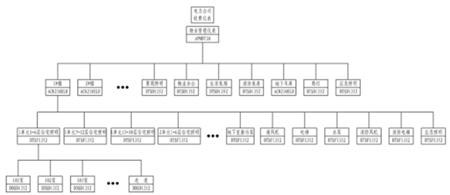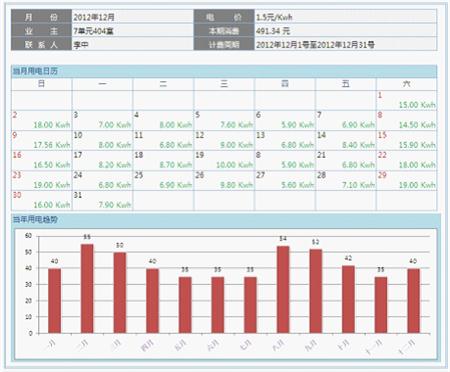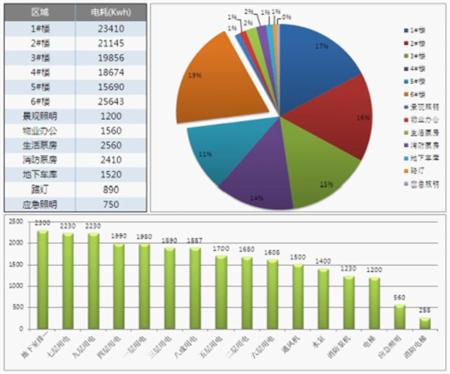Xu Shuang Ankerui Electric Co., Ltd.    Jiading 201801 1 Overview There are currently two types of electricity fee collection methods for residential communities. One is that the owner directly pays fees to the power supply department's payment network and applies to a residential area where a household has been installed. One is that the owner pays fees to the property company, and the property company pays fees to the power supply department in a unified manner, which applies to a district where the whole district uses a master table and each sub-table is installed. “One household, one watch†is the trend of power supply in residential communities. However, due to the “one household, one watch†transformation project involving the updating and expansion of lines and transformers , as well as the commitment of reform funds, the full coverage rate has not yet been achieved. The system described in this article is mainly applicable to the energy statistics and charges of residential districts that have not been transformed by “one household, one surfaceâ€. 2 residential community meter configuration For an unmodified residential area, the power company charges under an overall meter costs a manner that will install a total meter to the power supply point of a cell, electricity summary table then check by the power companies, electricity households on behalf of the property company to charge . Property companies in order to obtain power usage of households, the current common practice is to install household metering instruments for each household and arrange several electricians to perform meter reading and daily maintenance. Due to the large number of household meters, the property must be equipped with a considerable number of electricians, because of the manual meter reading and accounting, together with the leakage of electricity, and the sharing of public parts, resulting in property and property owners because of electricity charges. There are often contradictions. Residential area property electricity charge system is configured with smart meters at each power use point, and uses back office management software, which can reduce the workload of the property company while enabling owners to inquire about their own power usage at any time, so that they can clearly Payment. According to the principle of stratified classification and configuration, each power consumption point meter separates the electricity used by the owner from the electricity consumed by the public part. Meters are measured at the total incoming line and at each branch, which facilitates the verification of electricity usage. The specific configuration scheme is shown in Figure 1. Figure I Residential energy meter configuration scheme 1) Incoming line configuration Configure the APMD730 smart meter as the management instrument of the property company at the power supply point of the community. APMD730 intelligent instrument can detect three-phase current, voltage, active power, reactive power, power factor, apparent power, grid frequency, active energy, reactive energy, 2-31th order harmonics, total harmonic content, voltage Crest factor, telephone waveform factor, current K factor, voltage and current imbalance, peak voltage, voltage and current sequence, waveform tracking display, multi-rate energy statistics, maximum demand records, SOE event records. The APMD730 instrument can check the power quality of the power supply while comparing with the electricity meter installed on the edge of the power company to ensure the reliability of electricity consumption in the community. 2) Owner electric circuit configuration The owner's power circuit meter is configured in three layers, and the first floor is equipped with an ACR230ELH smart meter at the entrance of each building. ACR230ELH smart meter can detect three-phase current, voltage, active power, reactive power, power factor, apparent power, grid frequency, active energy, reactive energy, 2-31th order harmonics, total harmonic content, voltage Crest factor, telephone waveform factor, current K factor, voltage and current imbalance, voltage and current sequence, multiple rate energy statistics, and SOE event records. The electricity usage of the whole building can be recorded, and the quality of electricity for the building can be checked. The second floor configures the instrument according to the unit, and each unit is measured separately. If the number of floors of each unit is large, several meters can be set in one unit. As shown above, each unit is equipped with three DTSF1352 energy meters. The DTSF1352 meter can detect three-phase currents, voltages, and active energy, and it is convenient to count the total number of owners of lighting power for the corresponding number of floors. The third floor is measured by households. Each household owner installs a DDSD1352 meter. The DDSD1352 meter can detect single-phase current, voltage, active power, reactive power, apparent power, power factor, grid frequency, and active energy. Shows the electricity usage of each household owner and provides the basis for the owner to pay the electricity fee. 3) Utility configuration The public facilities are equipped with DTSD1352 multi-function electric energy meter for separate charging according to lighting, property office, pump room, elevator, firefighting and other purposes. DTSD1352 meter can detect three-phase current, voltage, active power, reactive power, power factor, The apparent power, grid frequency, active power, and reactive power are convenient for the real-time use of the property by the actual user according to actual households . 3 Residential Area Property Electricity Charge System Function Interface 3.1 Residential Energy Main Page In the area of ​​residential property power charges, the property management staff can understand the electricity usage of the entire community on the same day and compare it with yesterday. The unreasonable situation of electricity consumption is found immediately. The electricity consumption in the main areas of the residential area is represented by a line graph. 3.2 Single Household Energy Consumption Statistics Community owners can log in to the system to inquire monthly electricity history records and consumption amounts. The system displays electricity usage records in the form of calendars at a glance, and at the same time displays the monthly electricity consumption trends of the owners in the form of bar graphs. 3.3 Small households The residential property management personnel can automatically count the power usage of each owner through the system, and automatically summarize the summary according to the construction unit, statistically record the owner’s payment records, and help the property to charge. 3.4 Electricity Consumption Statistics in Residential Areas The system automatically summarizes the electricity consumption of the main electricity consumption areas during the specified time period and displays it in the form of a pie chart. After clicking on a key area, the system will further expand the details of the electricity consumption in the area so that the property can clearly understand the entire community. Electricity situation. 4 Quotation Scheme for Residential Community Property Electricity Charge System Numbering name model Quantity unit price Subtotal Instructions 1 Power Quality Analyzer APMD730 1 4,500.00 4,500.00 Check with the power supply bureau's master list to monitor and ensure the quality of power supply 2 Power Quality Analyzer ACR23OELH 10 2,400.00 24,000.00 The total table of each building, calculated according to 1# to 10# building 3 Multifunctional energy meter DTSD1352 7 900.00 6,300.00 Public lighting such as landscape lighting and street lamps 4 Three-phase electric energy meter DTSF1352 60 600.00 36,000.00 Two units per building, 18 layers, one distribution circuit per 6 layers 5 Three-phase electric energy meter DTSF1352 70 600.00 42,000.00 Public buildings such as ventilators, elevators, and emergency lighting in each building 6 Single-phase energy meter DDSD1352 1800 350.00 630,000.00 For each household, calculate according to 1#~10# building 7 Communication cable RVVSP2×0.75 2000 3.50 7,000.00 All instruments are centrally installed in substation low voltage inlet and outlet cabinets 8 Data collector Anet-Lx8 2 5,500.00 11,000.00 The data collector is installed in the data acquisition box configured in the substation 9 Power Management Host workstation 1 6,000.00 6,000.00 Optional Lenovo / HP / DELL and other famous brands to ensure stable operation 10 printer Laser/Needle Printer 1 2,000.00 2,000.00 For energy report or document printing 11 Power Management System Software Acrel-3000 1 30,000.00 30,000.00 Human-computer interaction, automatic collection and display in reports or other forms 12 Other auxiliary equipment Cabinets, isolators, etc. 1 10,000.00 10,000.00 Other auxiliary equipment or components that ensure the stable operation of the system Total 808,800.00 5 Conclusion Residential community property electricity charging system can enhance the property company's energy statistics accuracy, and improve work efficiency, is a set of practical customer-side management system. About the Author: Xu Shuang, female, undergraduate, Ankerui Electric Co., Ltd., the main research direction for the smart grid power distribution, Email: Mobile QQ "Electric Energy Measurement Management System Design and Installation" (atlas number: 11CDX008-5) is edited by China Construction Standard Design and Research Institute and Ankerui Electric Co., Ltd., based on the current national standards, combined with the classification of electrical equipment The measurement management requirements, the composition and function of the energy metering management system, and the design scheme for the energy consumption monitoring and analysis management of the electrical equipment are provided. The electrical energy metering system topological structure diagram, circuit diagrams of electric energy measurement and monitoring for DC, AC single-phase and three-phase electrical equipment are highlighted. Examples of energy metering management systems and types of electrical energy metering devices and related technical data are given for the designer to use. It is applicable to the monitoring and management of the energy consumption of electricity for civil buildings and general industrial buildings used in new construction, reconstruction, expansion and energy-saving reconstruction. If you need atlas, please provide your organization's name, department, address, zip code, contact person, contact telephone number, email address, fax 021-69155331, mail or QQ to Ankeru Xu cream engineer, Ankerui Electric will give you a free gift. . NYP high viscosity heat insulation rotor pump NYP high viscosity heat insulation rotor pump,High Quality NYP high viscosity heat insulation rotor pump,NYP high viscosity heat insulation rotor pump Details, CN Botou Honghai Pump Co.,Ltd , http://www.gearpump.nl



